Originally published by Le Monde 16th of February.
- Farm workers are not protected from pesticides.
- Their exposure has been linked to serious and deadly illnesses, including Parkinson’s disease and blood cancers.
- Recommended equipment, expensive, untested and rarely worn as it is, does not provide effective protection.
- Without this presumed protection, dangerous pesticides would be banned.
- French whistleblowing scientists have raised the alarm for more than a decade. They remain unheard.
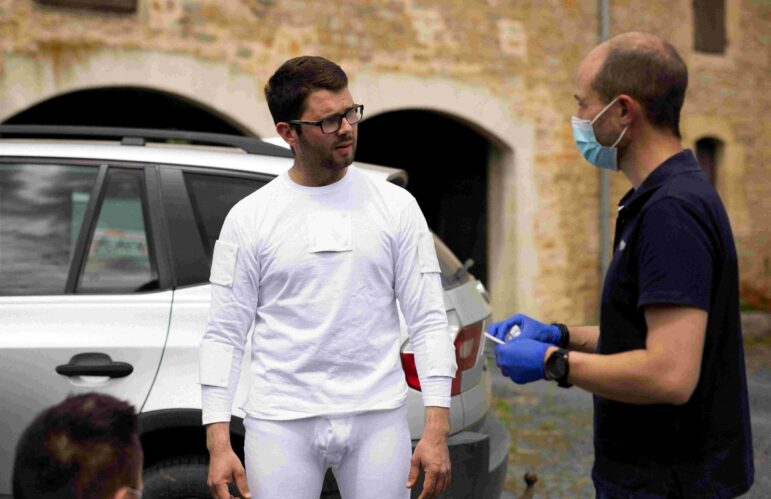
Jean-Baptiste Lefoulon is standing in boxer shorts in the middle of his farmyard. Four hands, swathed in blue, are busy clothing him: a long-sleeved T-shirt, white long johns, a zipped work suit bearing an embroidered logo for a brand of agricultural machinery, immaculate gloves that won’t stay that way, and a cap. With precise gestures and concentrated gaze, two scientists stick on those clothes 10×10 cm patches that they take out of the trunk of the car, which has been converted into a Batmobile for epidemiology.
On their farm at La Baucherie, in the commune of Lingèvres, in Normandy, France, the Lefoulon family, parents and son, grow cereals and maize on 100 hectares, and raise 140 dairy cows. The purpose of the study, in which he cheerfully participates “to advance science”, is called “Pestexpo” — short for “pesticide exposure”. On this afternoon of May 2021, the two scientists have come to record each of the young man’s actions in his most banal daily task, sowing his maize. Their three-layer patches will collect particles and dust loaded with pesticides: gauze, aluminum, adhesive, to keep it all in place. In case the pesticides penetrate, the aluminum will act as a barrier between the farmer’s job and his body. He is now equipped with a noisy pump and two hosepipes. In his bizarre pyjamas under the summer sky, Jean-Baptiste looks ready to go into space.
The “Pestexpo” study began more than twenty years ago in Normandy and in the Bordeaux region, in France. From its pioneering beginnings, this research soon dropped a scientific bombshell onto a pillar of the global intensive agricultural model: ‘the extensive use of pesticides’.
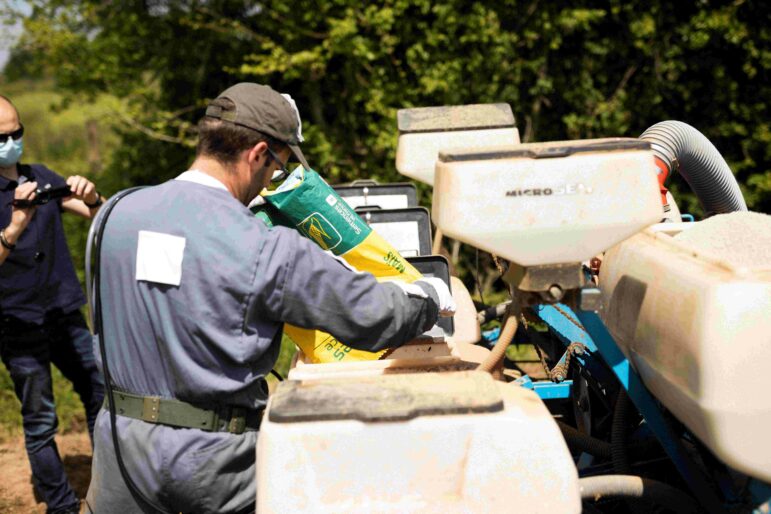
There is no “safe use” of pesticides
Observing the real-life work conditions of agricultural workers in field crops, greenhouses, apple orchards or vineyards, the Pestexpo team has demonstrated that they were much more exposed than previously thought. Worse still: the equipment that farm workers are supposed to wear for their protection simply doesn’t do the job. Perplexingly, in some cases, wearing coveralls or gloves might even increase their exposure.
What are the consequences for the health of the millions of agricultural workers potentially exposed across Europe? The Pestexpo researchers estimated that a worker can be exposed to more than a hundred pesticides in a professional lifetime, through the 15-20 applications carried out on average each year.
Manufacturers and regulatory authorities in all continents advertise that under “normal conditions of use”, pesticides pose no risk to human health. Over the past two decades, as the “Pestexpo” study established that these “normal” conditions do not actually exist, at the same time a growing body of scientific evidence from toxicological and epidemiological studies has demonstrated that pesticides are harmful to their health.
In June 2021, the world-renowned French research institute Inserm published a landmark report confirming that occupational exposure to pesticides was linked to at least six serious illnesses. After reviewing data from more than 5,300 scientific reports and studies from all over the world, a multidisciplinary group of experts concluded that pesticides can cause Parkinson’s disease, cognitive disorders, non-Hodgkin’s lymphoma and multiple myeloma – both cancers that affect white blood cells –, prostate cancer, as well as certain respiratory system disorders.
The concept of a “safe use” of pesticides, similar to that claimed in the past by asbestos manufacturers to keep selling their deadly fibres, is pure “fiction”. These are the striking terms used by the sociologist Jean-Noël Jouzel, director of research at the French National Centre for Scientific ResearchCNRS. “In theory, everything is put on the market with the idea that, when used in the conditions prescribed on the product label, pesticides will not cause undesirable effects,” the researcher explains. “But in reality, things don’t work out the way they look on the label.”
When reality poisons fiction
It’s 1999. Two young researchers meet during an epidemiology conference in Saint-Malo, Brittany. Isabelle Baldi and Pierre Lebailly wonder about the actual exposure of farmers to pesticides. There is almost no information available: most exposure studies have been performed or sponsored by the manufacturers themselves and the data, regarded as a trade secret, is kept away from public and scientific scrutiny.
As pesticides are intrinsically dangerous products designed to kill living organisms – insects, fungi or weeds that attack crops and livestock –, the scientists consider that independent data should be collected. Humans who apply pesticides are living beings as well, and can become their accidental targets. For this reason, the approval of pesticides is subject to numerous conditions in Europe. Agrochemical companies must provide data demonstrating that workers who use their products are at little or no risk.
In regulatory jargon, exposure to dangerous pesticides must not exceed the “acceptable operator exposure level” (AOEL). Extrapolated to humans from toxicity tests on laboratory rodents, the AOEL is “the maximum amount of active substance to which the operator may be exposed without any adverse health effects”. But in case the exposure does exceed the AOEL, the manufacturer applying for a marketing authorisation may add recommendations on the label. Wearing gloves, coveralls, goggles or masks – a whole range of gear known as “personal protective equipment” or PPE – is supposed to guarantee that farm workers’ exposure remains within the range of “acceptable”.
To find out if life unfolds exactly like the instructions on the sticker on a pesticide container, Baldi and Lebailly decide to set up an unprecedented study. They call it “Pestexpo”. “To tell the truth,” recalls Lebailly, “the message that everything was under control and that exposure levels were very, very, very low” was so widespread that, at first, they did not think they would find much.
This belief is atomised by their very first field observation of a Normand farmer in his thirties. “The guy had a degree in agricultural engineering and he put his bare hands in the pesticide tank!,” the researcher recounts. “My jaw was hanging open”.
It doesn’t take long to find out that there is a world of difference between the picture-perfect rural life depicted in both the law and instruction labels, and the crude reality of daily tasks on a farm.
Pesticides come in the form of powders, granules or liquids, and have to be mixed. “Unpacking, opening a canister, transferring to an intermediate container without receiving droplets is a fantasy in most cases,” explains Lebailly. The researchers see farmers climb up against a possibly contaminated tank to pour in the products or add water. Cans spill, mixtures foam, tanks overflow, pipes get blocked. And only 20 minutes have passed. Then it’s time to treat. In large crop fields, workers constantly pass under the dripping booms to get into the tractor cab. But many have open cabins: a gust of wind, or just a turn around and they are driving in a chemical mist.
Technical problems are constantly happening. The sprayer’s nozzles, especially, often get stuck with the batter-like sludge at the bottom of the tank. Climb off the cabin, pass under the boom, try to unclog the hole without dismantling the nozzle, fail, unscrew it, it’s under pressure, get splashed. Many just bring the nozzle to the mouth and blow into it. In Spain, they spit before they blow.
When spraying is over, you have to clean up the material (and there’s still this pesticide sludge at the bottom of your tank). If you grow apples or grapes, you and your employees need to go back to the plot to work or harvest while the fruits and leaves are still soaked with the product applied a few days earlier – activities called “re-entry tasks”.
Pesticides don’t necessarily smell or stain. How can you perceive the danger when it’s your daily life?
“People work in shorts and t-shirts. This may not be “good agricultural practice”, but it’s real life”, says Baldi. How, in this “fiction” of intensive agriculture under control, are farm workers supposed to work? “Like surgeons,” she says with irony, “who have both hands up so that someone behind them can put the gloves on, and then above all who touch absolutely nothing. That’s how it is done in a surgical unit, so it must also be done that way on a farm.”
“Should we stop the rain?”
For the regulatory authorities, indeed, facts of life observed in the “Pestexpo” study don’t match the standards of so-called “good agricultural practices“. They are viewed as “incidents” which cannot be part of the equation in the marketing authorisation process. “When the industry performs field studies, they retain the surprisingly low values, but if they find values that seem high, they designate them as outliers, i.e. data that should not exist because something went wrong”, explains Baldi, now 56 and director of the Inserm research team ‘Epidemiology of Cancers and Environmental Exposure’ (EPICENE) in Bordeaux and a world-renowned epidemiologist. Rain for example, is considered an incident. “Should we stop the rain?”, she asks.
Rules to evaluate pesticides were harmonised globally in the context of the creation of the World Trade Organisation (WTO) in 1995, with food products as a core issue. According to the “regulatory capture” customs of that time, the discussions took place between officials from regulatory agencies and pesticide manufacturers, under the aegis of NATO and the Organisation for Economic Cooperation and Development (OECD).
Archived minutes recorded the names of representatives from companies including Rhone Poulenc, DowElanco, DuPont or Bayer. Zeneca (now Syngenta) played a special role: Drafted entirely by an employee of the British company, Graham Chester, the guidance document, which sets out the methods for “conducting field studies to assess the exposure of operators, workers and bystanders to pesticides”, adopted in 1997, is still the reference today.
In a major book, Pesticides: How to Ignore What We Know (Presses de Sciences Po, 2019, French edition), which served as a basis for a good part of our investigation, sociologist Jean-Noël Jouzel meticulously reconstructed how the standards that govern the procedures currently in force in Europe were woven together.
In addition to setting in stone the gold standard of “good agricultural practices”, the OECD guidance determined the number of patches, the right methods to measure residues on hands or to take urine samples, etc. in an intellectual universe where the human body is considered in terms of surface area. Hands: 820 cm2. Head and face: 1300 cm2. Neck: 100 cm2. Whole body: about 2 square meters.
Mathematical models are also developed to relieve the pesticides manufacturers of the effort of making field studies for each product they want to put on the market. Known as the “German model”, the “UK POEM” and EUROPOEM, the models calculate the potential contamination of “operators” using older exposure data. They assume that protective equipment does reduce exposure by default. Hence specific “reduction factors” of 90-95 % are automatically applied.
According to those rules, concluded Jean-Noël Jouzel, “good data is data that is collected on subjects who have been well disciplined, who have worn their equipment well or, in any case, who have done everything right as it says on the label”.
What if they don’t?
In countless instances, the “Pestexpo” scientists observe, farm workers don’t wear any protection equipment at all. Roughly half use gloves in the preparation phase, a brief task. But treatment and harvest last for hours. Almost nobody uses coveralls for those.
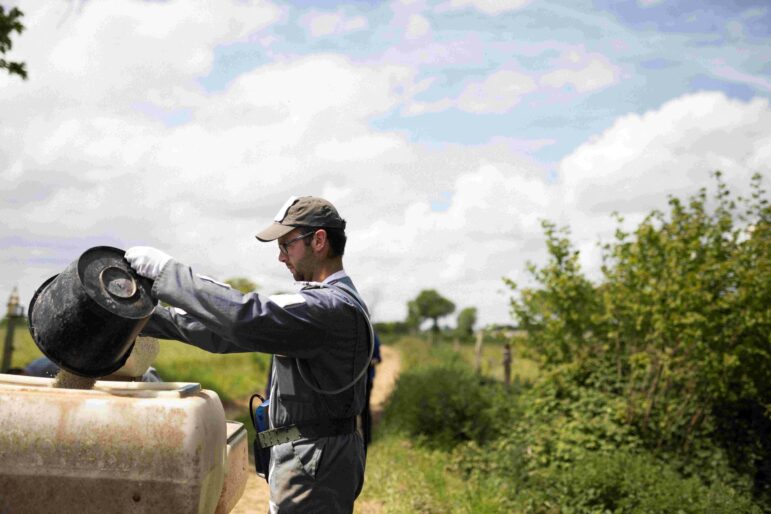
Wearing coveralls for six to eight hours when the temperature reaches 30° or 35° pushes the body’s limits beyond reasonable. “If they are confined in coveralls, in gloves and in a mask that prevent any thermal exchange, they are likely to suffer from hyperthermia and have heat strokes,” says Isabelle Baldi. “Yet the regulation for re-entry into viticulture and arboriculture is that workers have to wear fully covering clothing,” adds Pierre Lebailly, (University of Caen Basse Normandie) now principal investigator of the largest epidemiological study on farmer’s health in the world, Agrican (Agriculture & cancer). “It just doesn’t make sense to put up with this in terms of comfort.”
Then there’s the cost factor. Protection equipment is not cheap. The price of coveralls ranges from ten euros, for a disposable one, to over sixty euros for one that can be re-used for a while if washed. Their availability therefore relies entirely on the farm owners’ awareness and willingness to provide them to their employees, mostly seasonal workers, not to mention the illegal workers. “The labour force in re-entry or harvesting tasks is highly variable, with short-term contracts, sometimes on a per job basis,” explains Baldi. “So the priority is not always to provide them with a satisfactory level of information and protection.”
Only 30-40% farm workers use such equipment in France, according to the researchers. There is no data elsewhere.
Over the years, the Pestexpo researchers establish that the levels of exposure are, in fact, considerable, and largely underestimated in exposure scenarios and mathematical models. “Risk assessors are completely out of touch with reality”, says Lebailly. “But when we explain to them what we see, they reply: ‘Ah, but that’s dysfunctional’. Well, no…” Isabelle Baldi finishes his sentence: “… It’s real life!”
Field space oddity
At La Baucherie farm, as the central character of an agricultural remake of ‘Interstellar’, Jean-Baptiste Lefoulon drives his brand new red tractor across the fields, bedecked with whistling pipes. Arms loaded with equipment, the two scientists jog along behind, city sneakers sucked into the slushy road. In the field, the farmer tears open the big orange and yellow bags. Each maize seed is coated in a bright orange plastic matter containing fungicides prothioconazole and metalaxyl.
How could Jean-Baptiste sense the true nature of these 50,000 candy-like seeds, sprinkled with poison for fungi? He closes the four seeders: clack, clack, clack, clack! First task completed. The field scientists carefully take off the patches and wrap them in aluminum foil like square sandwiches for the train. “Left hand”, “right thigh”, they write with a marker pen. Eleven new patches are stuck on to measure the exposure specifically related to the next task: sowing.
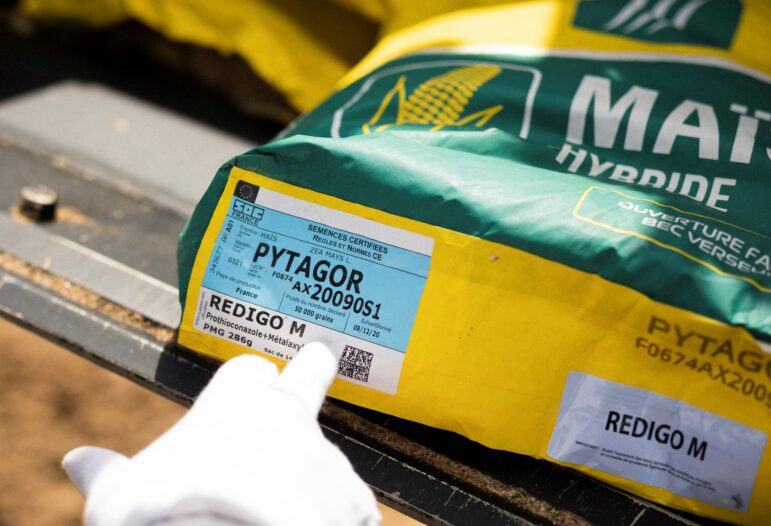
According to the French pesticides database Ephy, Jean-Baptiste should have worn gloves, coverall, a gown or long-sleeved apron, and even a half mask with a filter. There was no safety instruction on the packaging.
A truffle dog blows the whistle
In Bordeaux, another researcher got wind of the “Pestexpo” first results. “I had an important connection with Isabelle Baldi because our starting point is daily practice in the field. Like her, I don’t judge what people do or don’t do. We start from daily practices in the field”. Indeed, Alain Garrigou’s speciality is ergonomics, which consists in adapting the working environment to fit the worker. “In agricultulture however, man must adapt to work if he wants to limit his exposure to pesticides”, he says.
And reality is sometimes stranger than fiction. The group of scientists comes to realise that during treatment and cleaning phases, workers wearing coveralls were more contaminated than those not wearing any, respectively twice as much and three times more. The surprise is so intense that at first they think they must have switched the samples by mistake. “We were trapped by this implicit idea that wearing protective equipment was… protective”, recalls Garrigou.
Like a truffle dog of his native Périgord region, the ergonomist starts digging in scientific and technical reports, and goes from discovery to discovery.
First, he finds out pesticides can pass through plastic. Not slipping their way into imperfections in the materials such as holes, tears or seams, but at the intramolecular level. At that time, in 2006, assisted by scientists working in his lab, Syngenta had just performed tests on a common model of long-sleeved PVC apron, readily available from suppliers, with twelve pesticide products, including the herbicide paraquat, which will be banned in the EU a year later. Most worked their way through the plastic in less than twenty minutes, ten minutes on three occasions. Used for food wrapping, cables or shower curtains, PVC is completely waterproof: “Nothing gets through”, says Garrigou… “except pesticides”. A phenomenon called “permeation”.
“Pesticides have an exceptional penetration capacity”, he explains. “They are peculiar chemicals that are made to kill, but above all they are made to penetrate plant and animal cells”. Additives and adjuvants added to the active substance in the commercial formulations increase this capacity to get to the very heart of life, the cellular level. Industry has therefore been aware that protective equipment does not provide an effective barrier since the mid-2000s at least, and has not been able to provide a solution ever since.
It was only then that the ergonomist also realised that “there is no such thing as dedicated pesticide protection clothing”. The coveralls on the market were designed for the chemical industry, “but not to protect against pesticides”. They may be recommended in farming, but they have never been tested with pesticides specifically. What it means is that even if workers did use protective equipment, they wouldn’t have any guarantee to be protected.
It’s now 2007, and Garrigou and Baldi decide to blow the whistle.
A sorely missed opportunity for Europe
On 16 April 2007, Garrigou and Baldi detailed their findings and worries in an “alert note” sent to several official bodies and organisations in France. For them, “it is completely illusory, and even cynical to think that it is up to the user of plant protection products to ensure that the protection available to him is adequate” with the pesticides he uses. The worst thing in terms of prevention, they write, is to believe you are protected when, in fact, you’re not.
One recipient of the alert note takes it very seriously. At the French Ministry of Labour, a project leader at the Office for Occupational Hygiene and Safety orders an evaluation on ten coveralls commonly sold, some by major manufacturers like DuPont or Microgard. Published in 2010, the results are disastrous. Some models sold as providing the highest resistance let the chemicals pass through “instantaneously”. Only two coveralls provide the level of permeation resistance advertised. In France, real notice is taken of the alert, but not at the EU level.
It took another four years for the European Food Safety Authority (EFSA), the official body responsible for the assessment of risks linked to pesticides in the EU, to decide to replace the good old “POEMs” by a new model for the prediction of operators’ and workers’ exposure. In the meantime, in 2009, a new, overarching regulation governing the use of pesticides came into force. The rules now provide that dangerous pesticides have to be banned from the European market.
To develop the new European model, EFSA relies heavily on the preparatory work of an expert group set up by the German Institute for Risk Assessment, BfR. Almost half of its members are delegates of lobby groups for the pesticide industry. Among them: three employees of BASF and Bayer, and the same man who drafted the OECD guidance as a Zeneca employee, Graham Chester, now deceased. “All members of the working group have been subject to the EFSA Policy on declaration of interest”, the agency commented, in a response to our cross-border investigation.
Data, EFSA acknowledges in its 2014 guidance, is missing on many routine situations such as cleaning the equipment, spraying in greenhouses, and the crucial re-entry tasks. But the peer-reviewed, published studies of the Pestexpo team and others are not even mentioned; nor is the word, ‘permeation’. Even in the recent January 2022 updated version. “The EFSA Guidance is based on well conducted and validated experimental data”, wrote EFSA, adding that it “is acknowledged that there is a high public concern about exposure to pesticides.”
For the French researchers, this is a sorely missed opportunity. The model, like its predecessors, is based on unpublished, confidential exposure studies conducted by pesticides manufacturers, following OECD’s “Good Laboratory Practices” and “Good Agricultural Practices”.
“What is the precise meaning of the term ‘Good Agricultural Practice?’”, Baldi and Lebailly asked during the public consultation preceding the publication of the Guidance. EFSA’s reply tells it all: “This means that a model can be based on the assumption of correct conduct and cannot include accidents or misbehaviours”.
As it relies on the same kinds of industry-sponsored studies and regulatory assumptions, EFSA’s old model, dressed up as new, still assumes that coveralls and gloves offer protection. Besides, EU regulators keep taking it for granted that re-entry workers wear covering personal protective equipment during long, warm, working days. The “PPE factor” in the equation still allows an automatic reduction in 90-95% exposure “discount”, for which no public source is available. This makes it possible for the pesticides companies to nonetheless get their product into the market whenever exposure levels exceed the first tier of the “acceptable operator exposure level”. “With PPE, anything passes,” comments Pierre Lebailly. Is PPE some kind of a magic wand for pesticides manufacturers?
Pesticides in the fields, poison in the workers
Over the years, the French researchers have become this multidisciplinary group bound “by the issue of social justice”, says Garrigou. As they saw nothing was changing concretely for workers, they decided to write a proper scientific review of all their findings on PPE. “Some dangerous products have received marketing authorisation only because it is assumed that wearing PPE considerably limits exposure”, they concluded. “Without this assumed protection, they would be banned.”
Published in late 2019 in the peer-reviewed journal Safety Science, and co-signed by a total of fourteen authors from five countries, the article was swiftly attacked by the pesticide industry through its lobbying organisation CropLife Europe (formerly known as the European Crop Protection Association, ECPA). In a letter to the journal, the lobby group accused the researchers of taking “an emotive stance”, “overstated at best and misleading at worst”. In a written statement to Le Monde, CropLife Europe, which declined an interview, said: “we did not feel that it presented a balanced view, exaggerated the health risks for operators and over-emphasised reliance on assigned protection factors in the registration” of pesticide products.
However, the pesticide industry was not sitting back all this time. “They were clearly rushed by our alert,” believes Garrigou. “They absolutely had to find a solution that had both a scientific and a regulatory seal.”
The main “solution” came in the form of an international standard for “protective clothing” for “operators applying pesticides and for re-entry workers”. Initially issued in 2011, to be later revised in 2017, the norm “ISO 27065:2017” was introduced by the International Organization for Standardization (ISO). Yet the phrase “Personal Protection Equipment” was not used, and for good reason. The ISO norm indeed redefined the average work suit, typically royal blue or gray, treated with water repellent, as the official protective clothing for farm workers. A similar ISO norm for gloves was issued later in 2019.
For Jean-Noël Jouzel, this is no more than an upcycling operation of the work wear. “There is not even a permeation test with this type of garment: it passes through so quickly!”, says Alain Garrigou, baffled.
Most people are not aware that ISO is not a public body, but an entirely private organisation… whose 167 members are also private national standards “institutes”… the members of which only need to pay to access a great variety of technical committees. From acoustics to country codes, from dentures to insect electrocutors, ISO has developed over 24,000 standards that were incorporated in our daily lives in the past 70 years.
As a member organisation, the American National Standards Institute (ANSI) initiated the whole process, ISO told Le Monde. But who were the experts who developed the “ISO 27065:2017” standard? Impossible to know precisely; the list of the dedicated group’s members is kept secret. “In accordance with ISO’s ethical rules, it is not possible to communicate this list by name”, AFNOR, the French ISO member, told Le Monde in an emailed response.
The group leader, however, was Anugrah Shaw, a Professor at the Department of Human Ecology at the University of Maryland Eastern Shore (USA). At the helm of an international consortium consisting of pesticide manufacturers, academics, and officials from regulatory authorities, she has developed the norm in parallel with the ISO work, with support from BASF and the French lobby group UIPP, and with funding from the French Ministry of Agriculture, Ms. Shaw explained in an email.
As for the head of ISO’s permanent technical committee for Protective clothing, Eric van Wely, he happens to be a Global Regulatory Affairs & Standards Manager at DuPont, both a pesticide manufacturer and a leader in occupational safety and equipment.
The pesticide industry has seemingly produced data to support the metamorphosis of a simple work garment into protection equipment as early as 2008. Published in a scientific journal, a study sponsored by CropLife Europe on “11 operators using similar hand-held spray guns in greenhouse pepper crops” in Crete, Greece, concluded workwear made from the basic “cotton/polyester” material “could be considered as appropriate tools of personal protection”.
For Garrigou however, the ISO standard is far from appropriate. Even after a water repellent treatment, basic work wear can only limit pesticide contamination, and certainly not avoid it. What are farm workers supposed to do with all this? “They are required to wear protective equipment but if they don’t, it’s their fault”, says Isabelle Baldi. “And this is unacceptable because it means that we are rejecting a collective responsibility that starts from the moment a substance is put on the market or even conceived onto the final link of the chain”. Pierre Lebailly finishes her sentence: “A final link who doesn’t have all the knowledge to make a choice.”
This is Part One – See stories and team-members.
Other reporters contributed to this story. The cross-border investigation on ‘Pesticides at work’ is coordinated by Investigative Reporting Denmark, edited by Le Monde and Katharine Quarmby, and made in collaboration with journalists from Le Monde in France, Knack in Belgium, Tygodnik Powszechny in Poland, Ostro in Croatia and Slovenia, IRPI in Italy, De Groene Amsterdammer in The Netherlands, Ippen Investigativ in Germany, Marcos Garcia Rey from Spain and The Midwest Center for Investigative Reporting in US. The investigation is supported by Journalismfund.eu and IJ4EU.
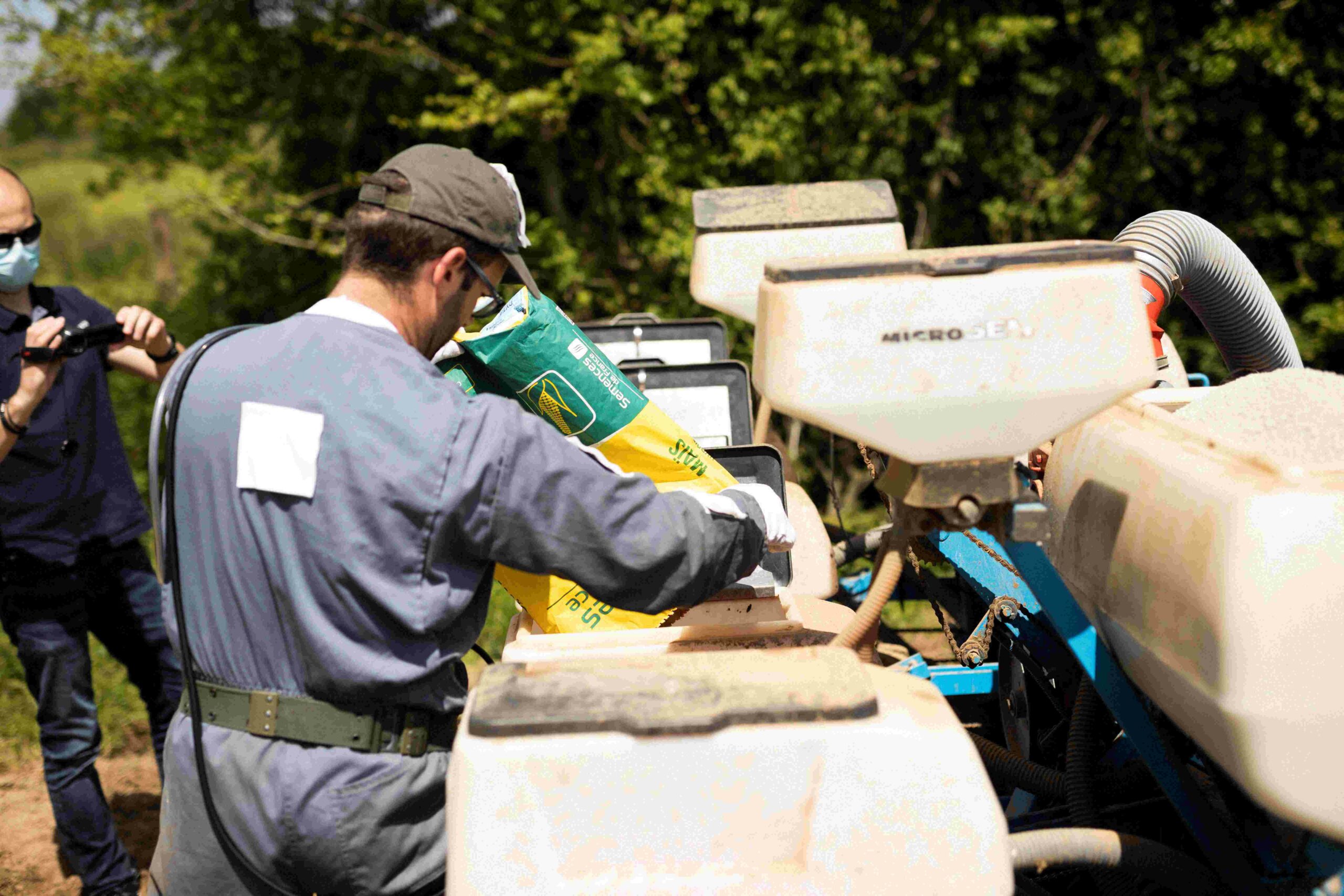
Pingback: Poisoned farmers: exposing the myth of pesticide protection in Europe - Investigate MidwestInvestigate Midwest
Pingback: Have the Children Been Poisoned? - Jeffrey A. Tucker
Pingback: Have the Children Been Poisoned? - United Push Back
Pingback: Here’s a wild idea – let’s stop poisoning our kids! – UK Reloaded
Pingback: Have the children been poisoned? – altnews.org
Pingback: Have the Children Been Poisoned? - Good Care Feels Better
Pingback: Toxische stoffen voor kinderen mogelijk gevaarlijker dan een virus - Good Care Feels Better